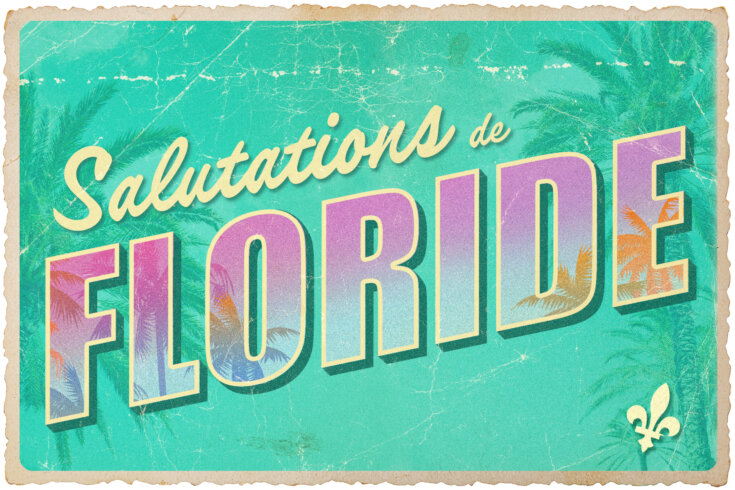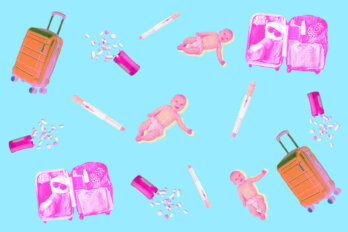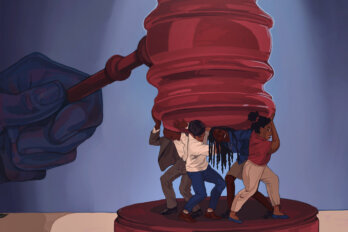B onhomme Carnaval is a long way from home. A statue resembling the Carnaval de Québec’s iconic red-toqued snowman grins from the corner of a courtyard at Richard’s Motel in Hollywood, Florida. It’s early November, balmy and quiet aside from Michael Jackson’s “Smooth Criminal” playing over the speakers scattered around. Air conditioners click on and off as I scan the nearby buildings—the clay-tiled two storey behind Bonhomme, the shingled bungalow to my left—trying to decide where Richard’s Motel starts and ends.
Richard’s Motel isn’t a motel. It’s a patchwork of properties owned by Richard Clavet, who grew up in Quebec City. Clavet’s mini empire is made up of eight properties concentrated in Hollywood and nearby Hallandale Beach, all of which cater to Quebec snowbirds.
By mid-December, Bonhomme will have better company than anxious geckos and gyrating palm trees. Known as le parc de l’amitié—friendship park—the place will fill with French Canadian snowbirds toasting yet another escaped Québécois winter with free hotdogs and French music.
To the guests at Richard’s Motel, this is the essence of Little Quebec. But to the next generation of Québécois, unhindered by language barriers and with a less staunch view of cultural preservation, Little Quebec is their grandparents’ sunny dream. And it’s fading out.
J acques Girard greets me by the check-in window at Richard’s Motel. He tells me Clavet’s a busy man, but as an “ambassador,” he’ll give me the tour.
Girard, a fifty-six-year-old from Saint-Jean-sur-Richelieu, Quebec, has a salt and pepper goatee and polarized shades. He’s the third generation of Quebec snowbirds to make the pilgrimage (his grandmother wintered in Florida from the 1960s to the ’90s, and his dad visited in the ’80s). Girard discovered Richard’s Motel in 2000 and has been coming ever since. Having retired last year, Girard, his wife, Nathalie, and their dog, Spike, now spend six months at Richard’s Motel, starting in November. Girard’s daughter, who’s thirty-three, no longer makes the trip. “She would come down, she followed us for a long time,” he says. But it’s different now for snowbirds like Girard. “I see a lot of families come here, but when the kids get to a certain age, they don’t want to follow anymore.”
He leans into a closet-sized office filled with television receivers and cables and introduces me to a trio of men, one of whom is called Mr. Legault. In the background, a news channel runs in French. Girard explains that the motel pays for subscription to French-language channels so guests can watch television in their language. Mr. Legault makes sure the service is working.
When I ask if that’s his job, Girard stops me. “We don’t work for Richard. We’re here as ambassadors . . . to make sure that this place continues ahead. We’re not here to be paid. Nothing is free for us.”
The hotel will be nearly all Québécois by December, Girard says. “No Americans, nobody else. All Quebec people.”
A block south is Richard’s Pet Friendly Motel, then Richard’s Hotel and the Green Seas Motel, purchased in 2015 and proof that Clavet was done naming things after himself. There’s also Richard’s Apartments and Richard’s Motel Studios. Within a five-minute drive, Clavet also has Richard’s Motel Courtyard and Richard’s Motel Extended Stay. Standard rooms range from $56 to $220 (US) a night, some of the area’s more affordable price points.
The properties have an aesthetic continuity: a low-vibration Québécois frequency underneath the Floridian kitsch of concrete reptiles and earthworks. Fences are adorned with Quebec licence plates, and a near-scale moose (which Clavet jammed into a commercial van alongside his kids and brought across the border) stands under palms next to Richard’s Motel Studios. Then there are the balançoires, a marvel of patio design featuring a canopy and two benches with an affixed table between them, the whole structure gliding back and forth along tracks underfoot. “They don’t sell these here in the States,” says Girard. “[Clavet] buys them in Quebec and brings them back.”
In the Richard’s Motel Studios’ parking lot sits Mammy’s Cantine, a food truck run by French Canadian chef Dany Haman, which sells poutine, hot dogs, and tourtiere—a French meat pie. Haman moved down from Quebec in 1992 and opened Le Pole Nord, a French Canadian cafe near Hollywood Beach, before rising rent forced him to shutter the spot in 2010. Haman says his wife, Monique, helped establish the first branch of the Quebec-based credit union Desjardins in Hallandale Beach in 1992.
Two blocks south, in a retail space within Richard’s Hotel, is Go2Vacations, a travel agency catering to French-speaking tourists and locals. Owner Jacques Cimetier says he books around 1,000 cruise cabins a season—almost entirely for French-speaking clients. “We don’t accept American people,” says Cimetier. Go2Vacations has three staff in Hollywood and three in Montreal. “We close the office for the end of March when the people leave to Canada,” he explains. They reopen in October.
As we move through the properties, it becomes clear that continuity is a placeholder for continuance—continuance of identity, of community, of belonging. For example, Girard explains, once you commit to a room for a set of dates, it’s yours year over year until you decide you don’t want it. “Nobody can rent your place from that date to that date,” says Girard. “Never, never, never.”
It’s a system rooted in preservation and security—elements that take on a deeper meaning in an area that has experienced tension over the years between the local Floridian population and French-speaking snowbirds who winter in Hollywood and neighbouring Dania Beach and Hallandale Beach.
Remy Tremblay, author of two books on the French in Hollywood—Vie et mort du petit Québec de la Floride (Life and Death of Little Quebec in Florida) and Floribec—says that the contentious relationship between host and guest (to borrow tourism terms) was fuelled by the rapid spike in French-speaking visitors to the area in the ’90s. The Sunny Isles Beach and Surfside to the south, near the border of Miami, had been the destination of choice in the ’70s and until the ’90s. But the expansion of Miami pushed hungry developers north, who demolished the modest hotels, motels, and apartments favoured by the Québécois snowbirds and replaced them with luxury high-rises. Further north, Hallandale Beach, Hollywood, and Dania Beach became clear successors for their affordable motels and inner-city RV parks.
Tremblay says Johnson Street, an L-shaped strip of businesses running perpendicular to the Hollywood Beach Broadwalk, catered to the Québécois tourists. “It was like the epicentre,” he says. Restaurants like Le Pole Nord and Frenchie’s Cafe and their patrons spilled into the street. “Everybody congregated there,” says Tremblay, who remembers visiting in the ’90s. The bandshell on the beach, at the foot of Johnson Street, was the meeting point.
But Tremblay says there was a disconnect between what Hollywood wanted to be and what French Canadian visitors brought to it. “The kind of tourist, like the working class . . . they have their own look,” says Tremblay. He’s tempering his words, he says, in an attempt to be politically correct. “They don’t go there wearing Prada bathing suits and Chanel sunglasses. . . . It’s not, you know, Hollywood; it’s the other Hollywood.”
It feels superficial, maybe even exaggerated, but Tremblay points to an incident where, on January 8, 1992, Fort Lauderdale weekly XS (readily available at the time on the Hollywood Beach Broadwalk) ran on its front page an unflattering image of a Québécois man suntanning, with the words “They’re Back!” According to a 1992 article by Dan Sewell that chronicled the row for the Associated Press: “Disdain for visitors from the Great White North found its symbol, however, in a photograph of a man’s great white belly spilling well south of his bikini-style trunks.” The article also included the Quebec tourism minister’s response at a press conference a week later: “I’ve seen many U. S. tourists with big bellies in Quebec, including on [Quebec’s] beaches.”
It’s not hard to see how places like Richard’s Motel quickly became refuges—enclaves where belonging and identity were never questioned, places where Québécois could be Québécois.
A deeper question about identity and belonging in Little Quebec emerges when I visit Clavet that evening at his makeshift office in a house behind Richard’s Motel Studios. The interview is sprung on me by Girard after a quick call with Clavet. He tells me we’re going to see the boss. I wait outside Clavet’s office with Mango, a caged blue-and-gold macaw that has caught the attention of the game wardens. “He has to find a sanctuary for him,” explains Girard.
Clavet crosses the street, from the motel toward the house, flanked by staff and his wife, Edna. He’s wearing a maroon button-up and carrying a stack of papers. There’s something Napoleonic about him—the short stature, the entourage, his palpable confidence. I’m equal parts anxious and excited. It feels like I’m meeting a celebrity.
We shake hands, and Clavet leads us into the house, sitting behind an open laptop at the head of a kitchen table covered in more stacks of paper. Girard drops down in front of the television behind me.
Clavet, who’s sixty, likes living in America. “[Not] everything is perfect. . . . I can very much criticize things,” he says. “But overall I would say it’s better here.”
However, to Clavet, his French Canadian heritage is unassailable. “That’s my roots, that’s my heart . . . that’s where I’m from.”
Clavet arrived in Florida in 1985. He spoke very little English and didn’t plan on staying long. His grandparents were here, so it was a quick visit, then the plan was to backpack through Europe with a friend. When the Euro trip fell through, Clavet took a job at a motel in Fort Lauderdale, via a family friend.
In 1990, at twenty-five years old, he used a loan from his adoptive father for a down payment on a rundown motel called the Gem, renaming it Richard’s Motel. “I wanted a name that shows that there’s someone behind [the place] that cares—a face behind the name.” From day one, he knew Québécois would be his core clientele. But he also knew Little Quebec (a phrase he says he coined) was in a state of decline. “It was a lot more French before my time,” he says. In the ’90s, Clavet says, it was easy to find French-speaking realtors, immigration attorneys, doctors, and dentists. “It’s not like it used to be,” he says. “I see myself as the last one, or one of the last ones, standing in the area.”
I ask him if that’s what it’s all about—the preservation of the Québécois identity in Florida. “What are we trying to preserve? Are we trying to preserve something that doesn’t exist anymore? Or won’t exist anytime soon?” he says, rolling the question around. He tells me about taking his four daughters to Quebec City. He told them he wouldn’t translate for them. “You’re gonna have to figure a way to order your own food and communicate with people,” says Clavet. “Everybody spoke English with them. Everybody.” It wasn’t the Quebec that Clavet remembered. “There’s people that speak English everywhere,” he says. “The newer generation do not need [this] little place anymore.”
Clavet says he doesn’t think much about the future of the business after him. His wife speaks Spanish, the kids are more fluent in Spanish than French, and he’s been in the US for nearly four decades—longer than he lived in Quebec. His trips back have become less frequent over the years, though he says he still tears up when he visits where he grew up. “That’s where I come from—I would say that’s my land,” he says. But in the same breath, he says he’s always considered himself American, even as a child. “I live in North America, so don’t tell me that I’m not an American.”
T he next day, I sit down with Michel Seguin, the publisher, editor, and journalist behind Carrefour Floride magazine and Le Journal de la Floride, which, alongside Le soleil de la Floride, is the main source for French-language news in the region. Montreal-born Seguin, sixty-seven, publishes six issues from November to April, distributing 35,000 copies of the magazine monthly. His Facebook group Les Snowbirds de Quebec en Floride has just over 90,000 members.
Clavet was one of the first people Seguin met when he came to Hollywood in 1996, and when he launched the magazine in 2004, Clavet was his first investor.
When I ask him what he thinks of what Clavet’s built and whether it’s enough to preserve the identity of Little Quebec, he says that, at its core, when we talk about identity within this context, we’re talking about language—and, more specifically, a bilingual generation. “If you have a kid, probably at home, you’re going to speak French with mama and papa, but in the school, he’s going to speak English,” says Seguin. Little Quebec was a necessity. “In the past, it was more close because we had no internet. We had to go to different places together to talk together, party together.”
According to Statistics Canada data, the English–French bilingualism rate of the French mother-tongue population in Quebec has risen among younger people and core-aged adults in the labour market. Between 2001 and 2021, the rate increased by more than twelve percentage points for each five-year age group from ten to forty-four years. But there are fears of what that bilingualism means. A 2024 Leger survey found 70 percent of Quebec respondents fear that the survival of the French language is threatened in Canada.
G irard drives me to Johnson Street, the former epicentre of French culture in Hollywood. Other than a rack filled with Le soleil de la Floride and Carrefour Floride in a convenience store, there’s no trace of what once was. The original Frenchie’s Cafe was demolished and in its place is a Margaritaville. Girard explains that the cost of parking in the area has steadily risen from $1 to $6 (US), pushing Québécois beachgoers north.
The next night, Girard and Nathalie try to take me to a revived iteration of Frenchie’s in Hallandale Beach, but it’s not yet open for the snowbird season. We end up at Flanigan’s, a South Florida pub chain with a built-in liquor store called Big Daddy’s. Girard explains that it’s a favourite among the French Canadian crowd but we’re still too early for the season. It’s the most English I’ve heard spoken in a few days.
Afterward, we drive around Hallandale Beach, and they point out high-rises that used to be French Canadian snowbird-populated RV parks. We cross through a parking lot behind Big Easy Casino, which Girard says used to house a pop-up market frequented by Québécois visitors before it ended “sometime during COVID.” Girard laments the closing of the Greyhound track at Big Easy. Another hit to identity. Things are changing too fast.
I think back to the previous day, when Girard and I chatted over beers at the table in his Green Seas Motel room. He’d brought a few cases of Alpine Lager, the pride of New Brunswickers (Girard’s mom is from New Brunswick). I asked Girard what might happen to Richard’s Motel and Little Quebec when Clavet’s no longer around. He inhaled sharply. “I hope there’s a way to preserve it, but honestly, I’m not sure,” he says. Girard points to Clavet’s penchant for micromanagement—every item he brought in, from the balançoires to the Bonhomme; every phone call he took during our interview to verify individual booking rates; every time he glanced at the security screen to confirm a guest was who they said they were because he knows so many of them by name.
“He constructed this empire by himself and I don’t know . . . I don’t think so,” says Girard. “And that sometimes gets me a little bit scared, because I want to finish the rest of my life here. I love this place. I don’t see [myself] going anywhere else.”
W e build our entire worlds from little comforts. For Clavet, Girard, and the Québécois snowbirds, it’s French TV channels and tourtiere—reminders of home. But for all the talk of preserving identity, of creating space for French Canadianness in Florida, it seems to me that, at its heart, Little Quebec has always been about escape. And more specifically, escaping that indisputable attribute of Canadian identity: winter. It was the common denominator amongst the majority of guests I interacted with: they weren’t there to build a community; they were there to escape the snow.
Maybe Little Quebec is fading. Maybe this version of escape has served its purpose for the last generation of snowbirds who need it. There will always be another generation to give up on winter. And when they get to whatever sun-soaked, affordable, and snowbird-receptive paradise they find, there will always be little comforts to miss and fellow snowbirds to toast what they’ve left behind. If they’re lucky, another Richard Clavet will come along to package it all together.





